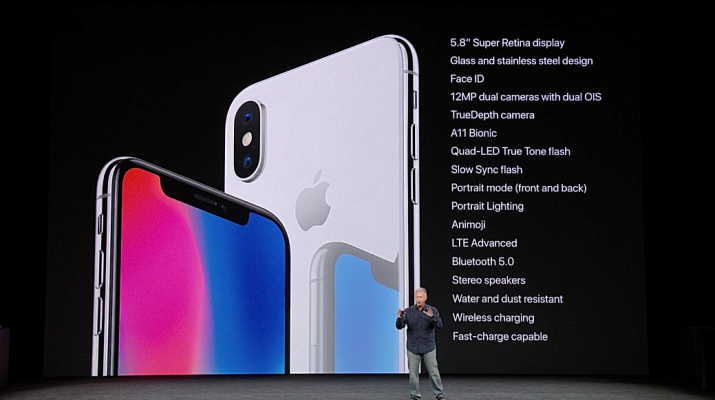Apple has unveiled the iPhone X – pronounced iPhone 10 – its premium smartphone costing more than £999 that showcases the latest technology, including an edge-to-edge OLED display, wireless charging and facial recognition security.
Apple chief executive Tim Cook revealed two other phones that upgrade its current range, called the iPhone 8 and iPhone 8 Plus, at the event in the Steve Jobs Theater at Apple’s headquarters in California.
The technology company’s other new products include the Apple Watch 3 and the Apple Watch 4K TV.
Apple fans have been waiting for the dramatic redesign of the iPhone, with some fanatics queuing up for the device hours before the event.
Here’s everything you need to know about and the best features of Apple’s new flagship product.
iPhone X price and release date
The iPhone X won’t come cheap. Apple will release two versions, a 64GB version, which will start at £999, and a more expensive 256GB version for £1,149 – ushering in the era of the £1,000 smartphone.
It will not ship until later this year. The iPhone X will be available for pre-orders on October 27 and be released generally on November 3.
What does the iPhone X look like?
The iPhone X has a 5.8-inch screen squeezed into a body smaller than the iPhone 8 Plus. Apple said it has been its goal to create “an iPhone that is all display”.
Apple has dropped the iPhone’s iconic home button, which has been present on every device since the first iPhone released in 2007. It has also removed the front-facing fingerprint scanner, which has been adopted by plenty of other leading brands.
Instead, the iPhone X has a nearly bezel-free design with the screen covering almost the entire front of the phone. To make room for the front-facing selfie camera and facial recognition, the screen has a slight notch that indents at the top.
It has a dual-lens rear facing camera and will come in the colours silver and space grey.
Key features | iPhone X
- 3D tracking technology will be used to unlock the phone
- Edge-to-edge display screens that cover the whole front of the phone
- No home button
- Face ID unlocks the phone using facial recognition software. Works with Apple Pay.
- New Portrait Lighting feature Machine learning creates facial landmarks and enhances light effects on the face
- iOS 11 will feature, among other things, peer-to-peer Apple Pay and a redesigned Control Centre
- Wireless charging already in use for the Apple Watch and will now be integrated into iPhones
- 5.8″ ‘Super Retina’ display Supports HDR in Dolby Vision and HDR10 and True Tone
- 64GB and 256GB Costs from £999 for 64GB version and £1,149 for 256GB. Available for pre-order from October 27 and ships from November 3
No home button (or Touch ID)
More of a controversial than a best feature, Apple has dropped the home button, which has been present since the original iPhone and was used to control many aspects of the iPhone, including unlocking it with the embedded fingerprint scanner.
Instead, the iPhone X uses gesture controls to unlock. Several functions of the home button, such as activating Siri, will be relocated to the lock switch. Users can control the phone through swiping up from the bottom or just by tapping the screen.
Wireless charging
The iPhone X is the first iPhone to come with wireless charging, which is already available on the Apple Watch and rival Samsung Galaxy S8.
Apple will also release a wireless charging pad, called the AirPower, that will be able to charge multiple devices at once. It will be released next year.
ALSO READ:Are You Ready For A Wireless Phone Charger?
Augmented reality
The iPhone X has been used to showcase some of the augmented reality experiences that Apple debuted with its ARKit software, released at this year’s WWDC. Augmented reality allows iPhone users to superimpose virtual images, games and videos onto real world objects and is a field where Apple has truly taken the initiative from rivals such as Google.
Face ID
Apple’s TrueDepth camera system lets users to unlock their phone by simply looking at it. Facial recognition technology replaces Touch ID as a way to identify users through an infrared camera.
Face ID will only unlock if a users eyes are open. Apple said there is a “one in a million” chance that someone else could unlock the iPhone using the technology. Face ID will also work with Apple Pay, and other apps that work with Touch ID.
Animoji
Animoji are a new form of moving emoji that can be customised using facial recognition software. Users can scan their face and the animoji will match their expression in a short animation.
The feature will only be available on the premium iPhone X, as it requires the 3D camera. Apple has created a limited selection of animoji from its hundreds of emoji, including the monkey, unicorn, robot, dog, pig, cat, dog and pile of poo.
Processor and battery
Inside the iPhone X will be an A11 bionic chip, a more powerful chip than the one found on the iPhone 8 and iPhone 8 Plus. The iPhone X will also provide two more hours of battery life than the iPhone 7, according to Apple.
Dual camera
The iPhone X will follow the iPhone 7 Plus and have a 12MP dual lens camera, but it will also be kitted out for augmented reality. The selfie camera will be 7MP and also be able to function for 3D tracking.
What about the iPhone 8?
Alongside the premium iPhone X, Apple also unveiled the iPhone 8 and iPhone 8 Plus

